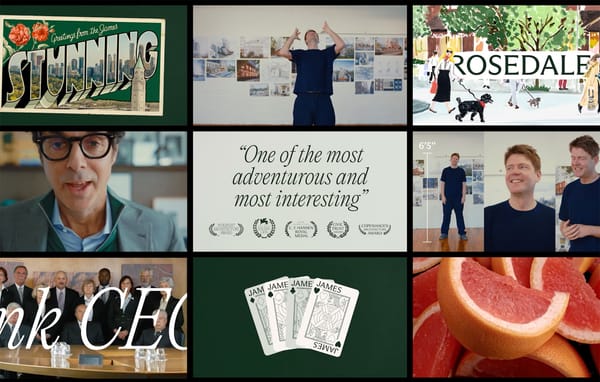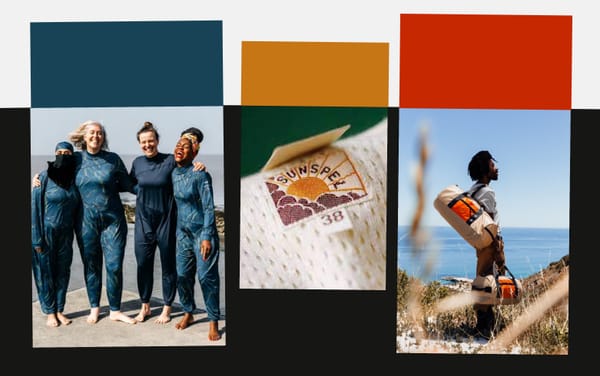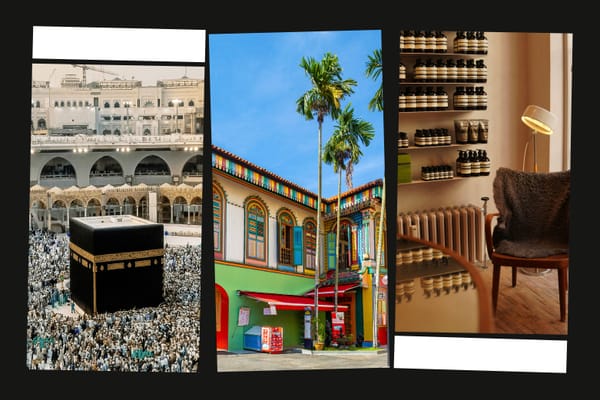Curator Andrea Andersson on the intelligence at the margins
The Rivers Institute founder on what’s possible when you take your time and build with community
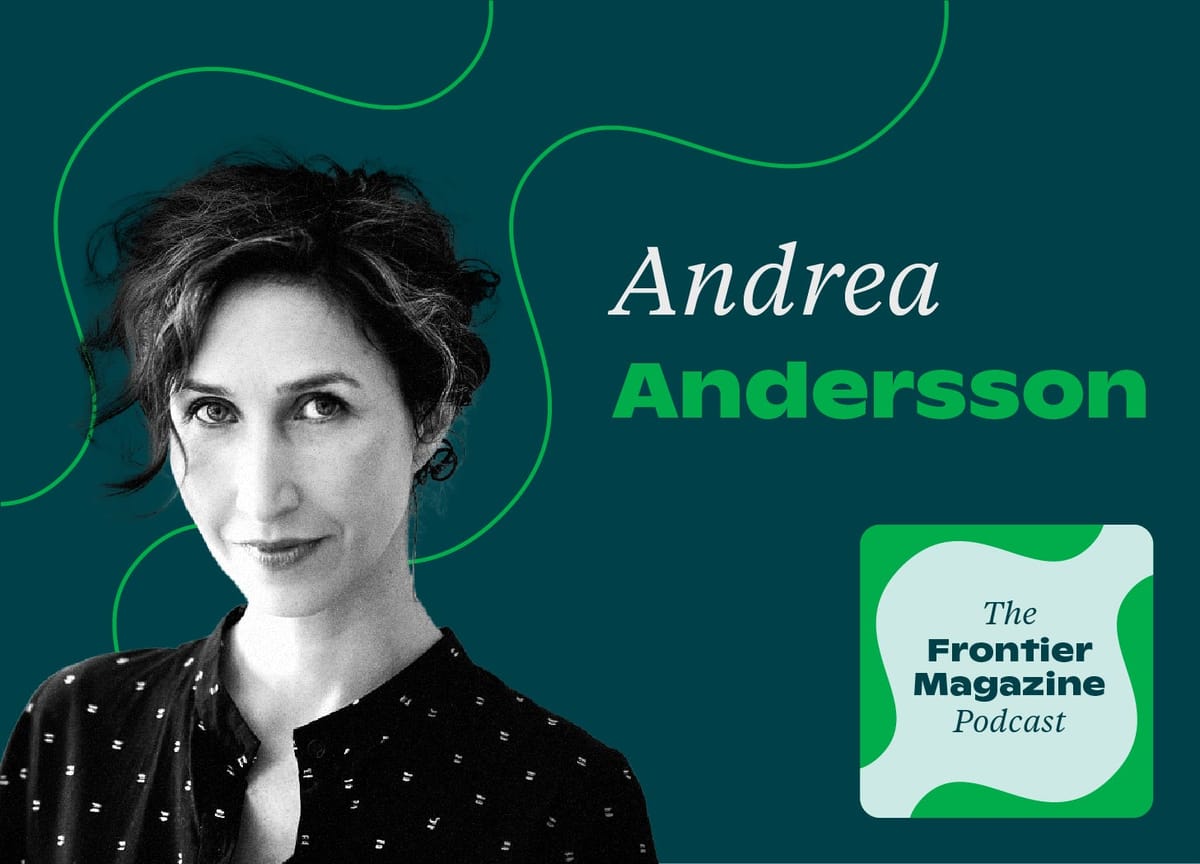
Episode Transcript
Andrea Andersson: I will always be an advocate for the intelligence of the margin. I think marginalia in books, it’s where all our best ideas go to live. Margins and peripheral spaces are also places where things come together, right? It’s the edge of multiple things. The site where we do the work has invited artists to operate a little bit differently and perhaps sometimes even test their own systems and frequencies. There’s an extraordinary amount of freedom there, and there’s room for error and humor.
Brian Sholis: I’m Brian Sholis, and this is the Frontier Magazine Podcast, where I interview artists, writers, technologists, architects, and other creative people about their work and the ideas and ideals that inspire it.
In today’s episode, I’m speaking with Andrea Andersson, a curator, writer, and the founding director and chief curator of the Rivers Institute for Contemporary Art & Thought. That nonprofit, founded in New Orleans in 2020, has quickly become recognized for its thoughtful, long-term collaborations with both artists and institutions, presenting exhibitions in New Orleans, Los Angeles, Western Massachusetts, and elsewhere with artists like Sanford Biggers, Yto Barrada, Troy Montes-Michie, and Helen Cammock.
You can learn more about Frontier Magazine and subscribe at magazine.frontier.is. Thanks for listening. And now, my conversation with Andrea Andersson.
BS: You’ve resided in New Orleans for quite some time, and the organization you founded, the Rivers Institute for Contemporary Art & Thought, is profoundly of that place. But you studied in the Bay Area and in New York, so I’d like to begin by asking you what brought you back to New Orleans, and also about how you settled into the city and into its artistic communities.
AA: I was born and raised here. My grandparents were all around, my cousins were all around. That’s a very New Orleans experience, multi-generational family living. Both of my parents are immigrants, and so we were both of this place and—I was acutely aware, from an early age—not of this place. We spoke two other languages that were not English at home, Greek and German, and that filled me with a sense of belonging very intensely to community, even if that kind of language-speaking signified difference. That childhood experience made me acutely aware as well of the many different communities that count New Orleans home.
And so when I returned to New Orleans back in 2015, we came back to a very different city. But there’s also a way that I never left. My husband and I came and spent an extended time here after Katrina, helping family. But it was also, for me, a coming home to discover all the different communities that live here and count it home. And it was important not to shape an organization that modeled a familiar narrative of New Orleans or a familiar identity of New Orleans, but really acknowledged its multiplicity, because that was my personal experience.
BS: The Mississippi River is a central feature of the city and of the New Orleans landscape. But a river is also a very powerful metaphor. It’s a stunning image in its own right. Tell us about the thinking behind the name Rivers Institute.
AA: It is a plural noun because it was intended to signify, from the outset, not just one river. I used to teach a seminar with an essay by André Aciman and Aciman wrote about being on the edge of edge of the Hudson remembering being on the edge of the Thames, which reminded him of being on the edge, on the edge, on the edge—[a] story of all of these sites of exile. And I think that lives in the name. And I think that lives in my own experience of both being here, but also knowing that “here” points to all of these other sites. I think New Orleans rhymes most closely with global port cities that are related by water and that are shaped by the exchange of goods and people.
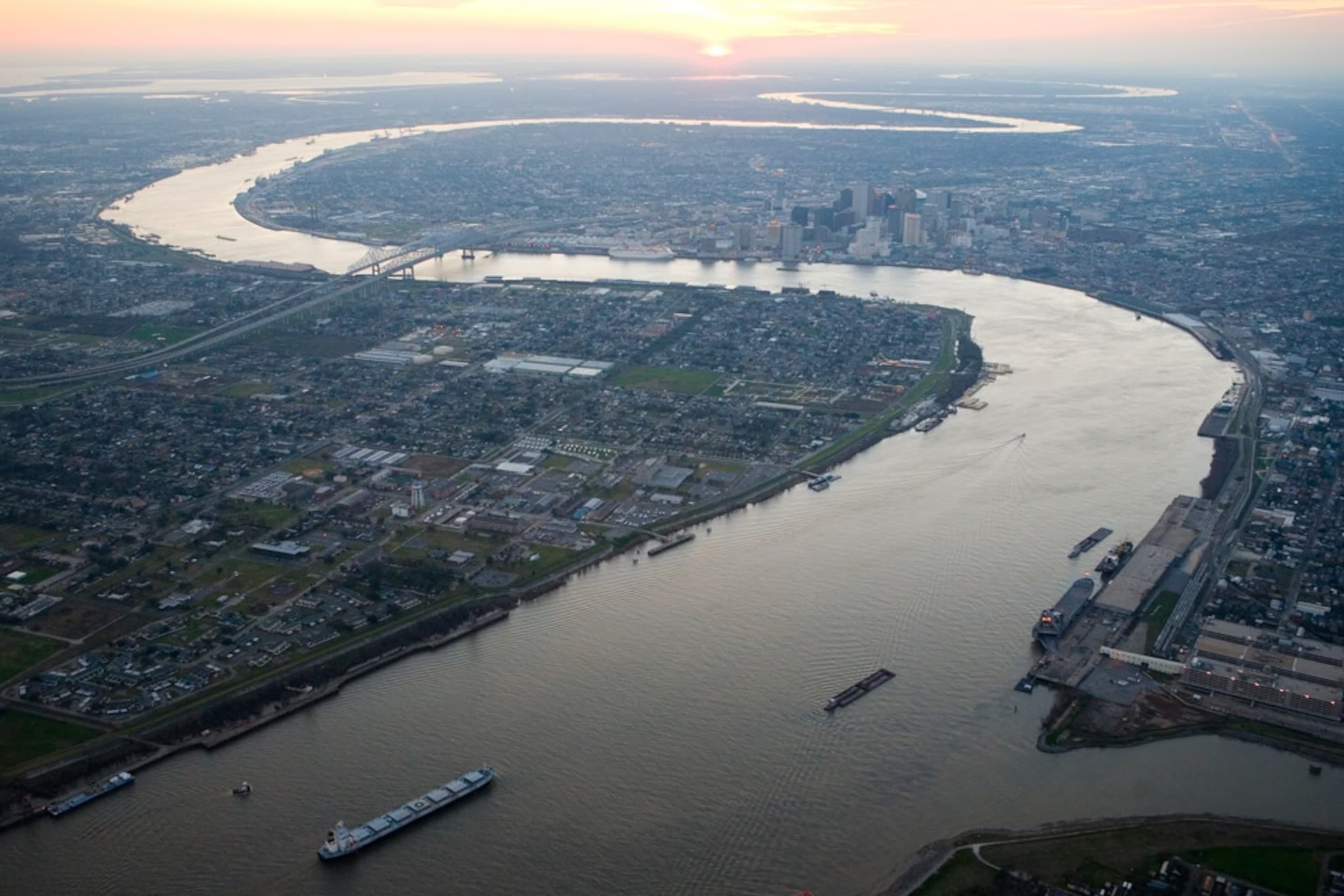
BS: Mm-hmm. Yeah, I think the other part of the name that I wanted to ask you about is the inclusion of “and thought,” art and thought. You’ve engaged deeply with writing after—or writing as—conceptual art. The Rivers Institute is one of the few organizations I know that publishes a bibliography of pieces that are influential in your thinking.
AA: I go back to it because my own training is not expressly in contemporary art. I don’t have a PhD in art history. I have a PhD in comparative literature, which was a department, frankly, that allowed for multiplicity. It allowed me to study multiple languages. And one of those languages could be visual language, right? How we understand signs and systems and semiotics. It was a space that allowed for different forms of thought to be studied.
And I think that that’s what Rivers is really invested in. There’s no expectation about objecthood at the outset. We don’t have a physical home. We are not gallery-oriented. It’s really following an artist’s thought process and understanding that that can take a lot of different shapes and often it can take the shape of language. I studied and taught poetry and poetics in another part of my life. And so that filters into our work. My colleague, another curator at Rivers, Jordan Amarkani, I think also would identify as a writer. Even when we’ve been building exhibitions with artists, there’s some level of sensibility that we know we’re all writing together.
BS: Mm-hmm. You mentioned in passing through that answer that there’s no physical gallery home. And as a result of that, partnerships are also an important part of how you’re reimagining what an arts organization can do. And I know that you've partnered with museums and with book publishers far and wide, but that at the heart of it all is a local partnership. And I wonder if you can talk about the Amistad Research Center and how that relationship informs what you do with the sense of hospitality you try and bring to artists from far-flung places.
AA: There’s something else I might want to add also as we enter into that, which is that we don’t have a gallery space, but we do now have a home, which is to say a physical residence. That idea of how it functions as a constraint is something that’s become really interesting to us. I think one of the things that it has done for us is foregrounded, or made visible, how much our work is non-public, [is] process-based. It’s the kinds of things that happen behind an intimate enclosure, right? Your word hospitality made me think of this. Coming together to sit for a meal, opening up boxes together, working on a book together, having a place for artists to sleep and rest, having a library, an artist studio. And so that sort of non-public space has become important to us in a lot of ways; everything we do really has to happen out of this one room. We can only be so big as this space affords us. When an artist is not in town, we use the space in other ways. And so this idea that we’re not going to get bigger was also part of our sense of self. And with that a desire for work that is fundamentally intimate.
So in order to do really ambitious projects and also to bring in more expertise and different ideas, that has to be done by partnering with those we trust. This is my sort of sideways way of getting back to your question. One of our founding partnerships was with the Amistad Research Center. Amistad is an extraordinary archive grounded in the history of the African diaspora, but which has expanded over decades to become a much more complex body of archival materials that acknowledge ethnic complexity. It’s both an ardently local archive and also global. When we founded this, I founded it together with my colleague, Kara Olidge. She was at the time the executive director of Amistad. She is now a director at the Getty Institute in Los Angeles. But we are both New Orleanians by birth and, you know, roughly the same age. We came together to really suture our areas of expertise.
When Kara and I formalized this idea, it was really about how do we anchor contemporary practice with material history and make sure that history is really sutured to these manifestations of futurity. And so we began this partnership which is anchored in the residency program but has grown in other ways. As part of the residency program we commission a new work by artists in the residency that enters into the fine art collection. So the very collection that fuels a lot of artist research is also revivified and complicated by new work. The Amistad collection is predominantly a nineteenth- and twentieth-century fine-art collection. So this really continues to march it into our current experience. But we’ve also expanded it to something called The Prepared Table, which is really the brainchild of a colleague of mine, Jade Flint. Each month, we invite three or four artists who live and work in New Orleans to what we call The Prepared Table. And we research and collect materials that are relevant for their practices beforehand and spend a season welcoming them back again and again. I think a lot of artists have had no idea that this is not only here, but it’s publicly available. This is a public archive and perhaps we make it more visibly so.
This was the first partnership, [one] that really established a way of working for Rivers. But as you said, we have continued to grow our partner network, our other trusted organizations. And I think the way that we best work together is in acknowledging that we know different things and that we bring to projects a very specific skill set and that we also trust in the other skill set. We are not an organization, for example, that has a gallery, that has a full team of registrars and marketing and communication specialists. We’re really in, you know, the development of projects and the narration and the structure. And then when it gets to that moment where it needs to meet a great big audience, we know there are those that know how to do that with great skill and experience. And we’re lucky to have some wonderful partners to share it widely.
BS: There’s also this idea that partnership enables longer-term sustainability, that arts ecosystems and especially the nonprofit arts ecosystem, and especially the nonprofit arts ecosystem in the United States, is one that’s imperiled or that’s challenging and fraught.
AA: I mean, we wouldn’t be here today, quite frankly, if we hadn’t already evolved this partner system prior to COVID. What it meant was that we could bring to each other different resources. So we were able to carry out programs and see them continue to happen in some shape. Sometimes it needs to be happening for more than one person, right? Or more than one organization. Like there are five of us who know about this project. And so therefore it can’t die quite in the same way. And we’re gonna figure out a way to continue to service it even if it’s also acknowledging that there are things about this that are gonna have to change. And I think that afforded us all a kind of nimbleness and a way of resting on another person at times.
And this has always been true of Rivers since the beginning. We were born into an under-resourced community, and frankly, one with not a profoundly deep or expansive philanthropic culture. And that meant from the outset that we knew that there are limits to what would be supported within New Orleans. There is no public support for art. I mean, it’s not like the city provides any resources. And regionally, I mean, it’s extraordinarily scant, I mean, even compared to other nearby states in the southeastern region.
And so we knew that we were going to have to build support from outside of the community. Our budgets could only ultimately support—hit this threshold. But that didn’t mean that our limits needed to be limits for the artists. So what does that mean? I think that what that meant for us was we needed to also be working in close concert with other partners. I think we enjoy the experience, the qualitative feeling of working with other relatively small- to medium-size organizations. We weren’t trying to be engulfed by or absorbed by or like a special project of a large organization. We were working with other small to medium organizations. And so for each of us, there is a kind of equivalence of contribution. And that results in a different kind of balance of exchange and partnership.
The other thing about our model is we never sought to kind of have a one-off relationship with a partner. We weren’t trying to do this once and say, “Oh, well, that was fun.” We are really looking [for] and shaping partnerships that are going to be multi-year. We’ve done four projects together with the California African American Museum. And what that really means is that over time, there’s built knowledge. It’s not inventing something from the first. I know the guy that installs the vinyl there [laughs]. And these are tiny little things, but you do grow institutional knowledge not just about ourselves, but about what the capacity is of your partner. And what the shape of something can be.
BS: Yeah, that last point is one that I had hoped to ask you about and I’m glad you touched on, because there’s something about duration that is important to the work that you do. It’s not just that you fly an artist in to install an exhibition, but that they come and they stay—they come multiple times and they get to know New Orleans. They get to know the Amistad archive. And then, as you say, on the flip side, some of those partnerships that you have with other institutions are years-long. They’re five-year partnerships. They span multiple projects. What is uncovered when you give it time? What kinds of insights, what kinds of things are possible to foster as an arts organization when you’re moving at those speeds?
AA: I want to say “Everything,” right? I feel like nothing about our projects would be possible if they did not take place over many years. They wouldn’t feel good, straight up. They also wouldn’t feel true. And I think that’s been a huge part. I think living in a city that is so reliant on tourism and a sort of shorthand understanding of very long and complicated histories commonly yields the same output over and over and over again.
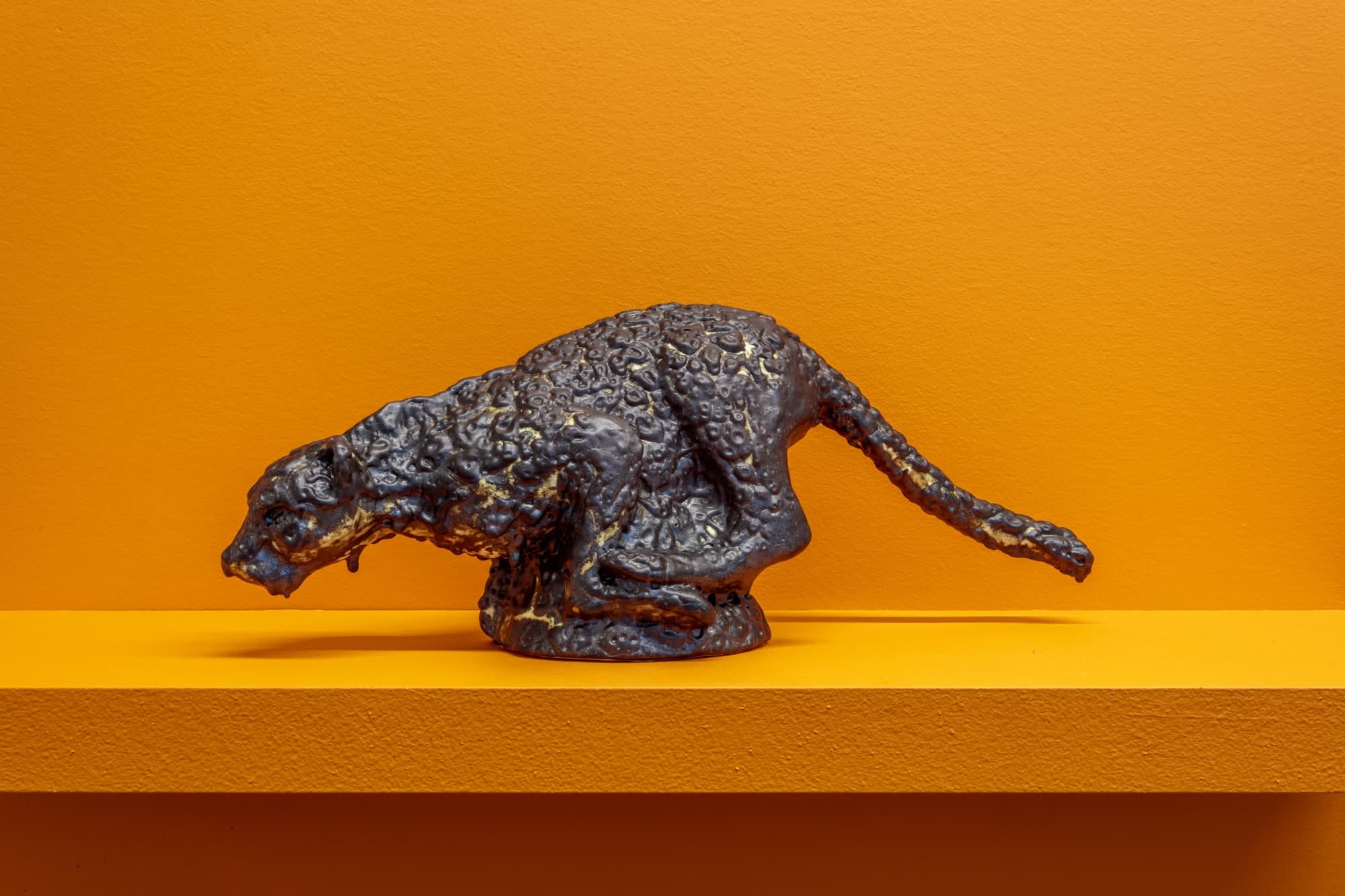
Helen Cammock was our first artist in residence in New Orleans, and we will present her work in October, her first North American film commission, at an hour and fifty-seven minutes. We will show that work, which is a kind of long-form, steady portrait of many different artists and culture workers in this community. I think we were all, including Helen, quite surprised by the final cut of the film, how many minutes it was. It was longer than her Turner Prize film, longer than the Max Mara film. And then you watched the film and you thought, “Oh, it had to be the longest one because the duration of that film was a registration of her respect for the people she was listening to.” These were not tight edits or cuts. This was affording an artist to take as long as they needed to take to tell their story. And there is a kind of tempo to that film that feels like affection, but also really just deep respect for the community that she spent time in. People gave her time and she gave it back.
This will be her fourth long stretch in the city. And in many ways, she also doesn’t need us as a kind of interloper anymore. She has her own relationship to this place. And she’s established her own questions and positions on things. And I think that is something that we really want to foster when artists are here. Yet we want to welcome you and provide hospitality and make introductions. At the end of the day, we want this to be a place that you establish your own quiet relationship to, on whatever terms that is.
BS: But not all of the art your residents make is about New Orleans …
AA: The work that we’re doing right now with an artist named Alia Farid, who is from Kuwait and Puerto Rico, is very much rooted in the wetlands, but it’s not in the southeastern Louisiana wetlands, it’s in the wetlands of Basra in Iraq. And her research and time here has enormously informed her sensibilities about that place, not only because of what is similar about New Orleans and Basra, or I should say the wetlands around these regions, but also what is profoundly different. She often would use the expression, “How do you call that?” And it was such a really revelatory turn of phrase because that means two things. “I’m curious about this, I wanna understand this,” but also “I already know. We come at this from different places.” And so I think, I hope, that there’s like a, “How do you call that?” in all of our work with artists. That there is enough time that there can be a kind of healthy estrangement from this place and a settling in to establish a familiarity of one’s own. You know, for so many place-making projects in art and culture, people usually are building their imaginations on a very small set of historical points, fragments, and there’s a kind of facsimile of something. And I think that gets disrupted over time and opens onto something else.
BS: Mm-hmm. Well, maybe I can go a little bit back to the beginning or to the opposition that I posed at the beginning between places like the Bay Area and New York and then New Orleans, because Rivers is pointed in its advocacy for the value of ideas from places that are considered the periphery. What does it mean to bypass all the traditional centers and to form your own network of relationships?
AA: I will always be an advocate for the intelligence of the margin. I think marginalia in books, it’s where all of our best ideas go to live. Margins and peripheral spaces are also places where things come together, right? It’s the edge of multiple things. Alia made a comment at one point when she was here and she was talking about “Gulfies,” that she had seen some Gulfies. And I laughed and I said, “Well, you know, I’m a Gulfie too. It’s a different gulf, but I’m a Gulfie.” And we couldn’t stop laughing. But those kinds of dissonance and those kinds of information that are regional and cultural and tradition-based—and this is not to say that centers of capital don’t have those things. But they’re often eclipsed by different kinds of moves and capital. You have to look a little bit more closely to start to notice the rhythms that are based on cultural tradition or, you know, geographical specificity.
The work that we do here, or, I should say, the site where we do the work has invited artists to operate a little bit differently and perhaps sometimes even test their own systems and frequencies. There’s no marketplace in New Orleans [laughs]. This is not the place where blue-chip galleries are operating. And so there’s an extraordinary amount of freedom there, and there’s room for error and humor.
BS: It’s more like life in that way …
AA: It’s striking. With all of the artists that we work with, we all talk about family. And frankly, my own family is a character in these experiences because it’s a residency. And when you host someone for a period of time, they get to hear your son’s guitar and other things, right? And it’s a different relationship. And so I think that also frames the importance of a different kind of knowledge, which so commonly gets excised or undermined in contemporary art culture. And so I think part of the work we do also makes a little bit more space for under-recognized bodies of knowledge. And I do think that time at the periphery allows you to sink into that a little bit more deeply and move differently from that space.
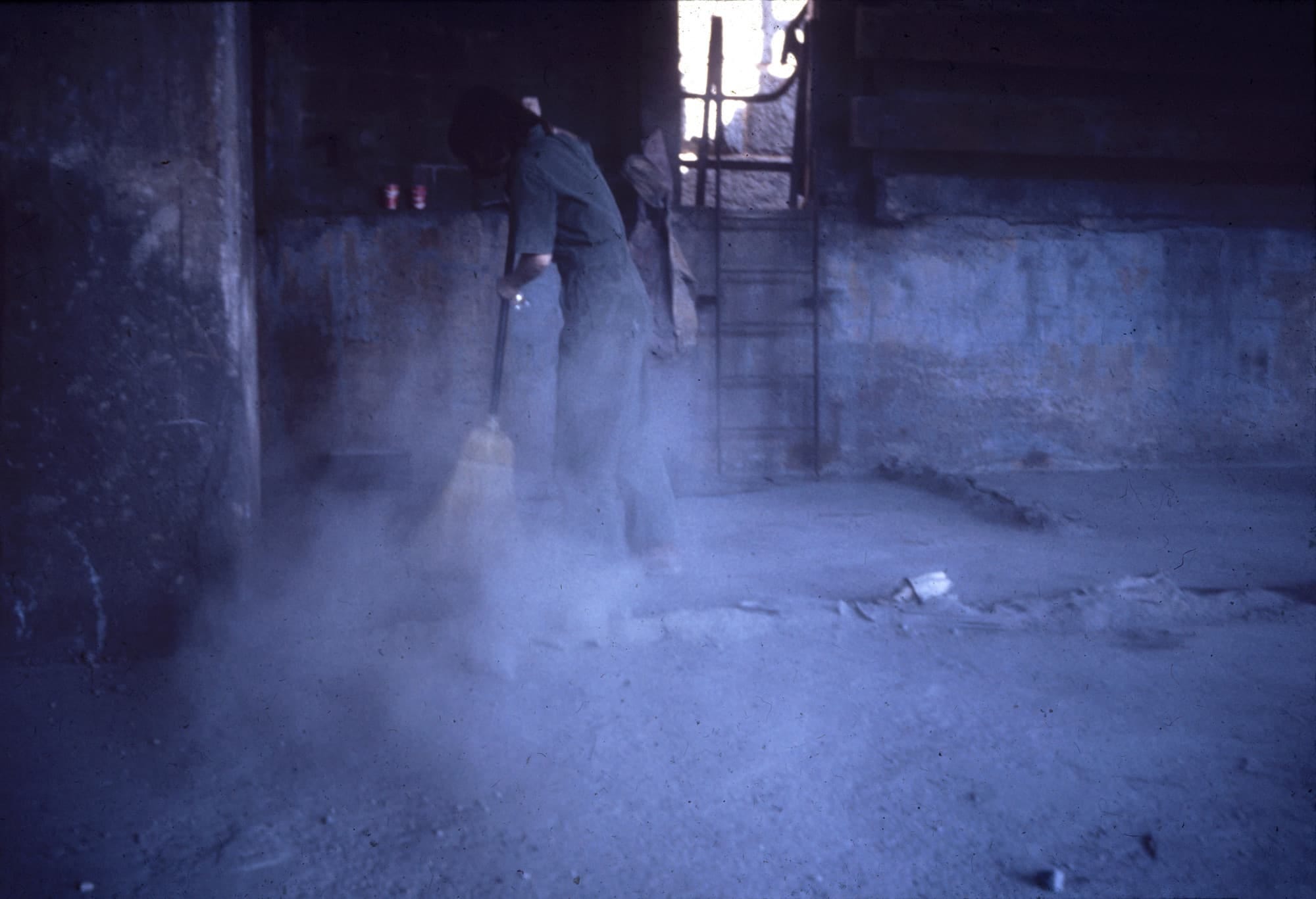
BS: So you’ve spoken eloquently about Helen Cammock and Alia Farid and artists that have come from elsewhere to New Orleans. And I wonder if you can just tell us a little bit about the artist Tina Girouard and about the exhibition and the publication that you’re working on around her work. And then also about how her work ties into this home that you mentioned earlier in the conversation.
AA: Tina Girouard is an artist who was born in Acadiana, Louisiana, in Cajun country near Lafayette, and who moved from Louisiana in the late 1960s to New York. She was a co-founder of some of the most important art spaces for downtown Manhattan, involved in 112 Greene Street, was a participant in [the] Anarchitecture group, co-founder of Food, the restaurant, in SoHo. She premiered many of her early works at The Kitchen, and participated in the first show at PS1 with her gorgeous installation Rooms. She was at the vanguard of that moment and I think enormously shaped that time and most people have never heard of her.
BS: I certainly didn’t know that history …
AA: I remember writing part of my dissertation on Gordon Matta-Clark and Tina’s name came up here and there. I wasn’t looking for her at the time, but I did begin to have the sense that there was this... kind of like, Louisiana mafia haunting the edges, right? Of the Philip Glass Ensemble, six people, I think in 1966, were all from Louisiana. We’ve subsequently found all these wonderful photos of Tina back in New Orleans with [Robert] Rauschenberg, just hanging out. There was this exchange happening. I don’t think this is the story of New York informing Louisiana culture. I think this is the story of a kind of Acadian culture, a knowledge of this community that knows exile, that knows colonization, that knows family, that knows how to work with what is at hand to make food and music and sound and spectacle and all kinds of things together and that togetherness being a really core component. And it was that importation into an evolving language in New York in the 1960s and ’70s.
We have been researching in her archive now for several years and we are in the process of developing and presenting her posthumous retrospective, which will open in New Orleans in March of 2024 and then in New York in the fall of 2024. And we’re working on an accompanying publication. It’s really hard to distinguish at this point, frankly, where my understanding of Rivers ends and where my inspiration from Tina begins. I mean, I think these things really have blurred because Tina was such an ardent experimentalist, but she was also so community-focused. It was about doing these things together. It was about leveraging your strengths and also, frankly, being pretty savvy with very little. She was a fierce grant writer, I have come to learn. I think for me, so much of my study of Tina’s work has been this sort of exchange for a 1960s sensibility about what “process” is, in exchange for what is ritual. And I think that’s a very Louisiana kind of information that she brought to bear, when something both plays a kind of social function and can be art at the same time. And that has become very central to, I think, the work of Rivers.
I think to live in a place that is as challenged as Southeastern Louisiana, there’s a different kind of pressure that I think gets placed on all kinds of work, but certainly culture work. And I think it needs to have both a social function and a life as art and have kind of double frequencies, because the questions of sustainability are ever present. And so everything has to do double duty, triple duty. And Tina knew how to do that.
We are an all-women’s organization. Everyone who works at Rivers currently is female-identifying. And there is a kind of feminist ethos that comes through, or that we’ve been sort of drawing and learning from, in Tina’s practice. And part of that has also been about how we recognize domestic spaces. And for us to go back to your question, the Rivers house, when is art—as it was for Tina—about cooking for friends and colleagues and making space and sweeping up after them? One of Tina’s great works [is] Swept House. And so when is that a kind of artwork? And I think, in this moment in which we are recognizing the unsustainable pressures for all art and culture workers, when is community care really not just auxiliary or an important thing too, but when is that the work? Like, full-stop. And for Tina, often it was sweeping and dusting and washing. That kind of care for the materials that we return to is ever an important reminder.
BS: It puts the phrase “preparing the table” in a new light.
AA: Yeah, for sure.
BS: Andrea, thank you so much for this conversation and for the inspiration that Rivers Institute represents. I appreciate it and I’m continuing to follow with interest from afar.
AA: Thank you. Thank you so much.
Thanks for listening to this episode of the Frontier Magazine podcast. It’s the audio component of our weekly publication, which features appreciations from the forefronts of architecture, technology, culture, and education. Each issue shares new ideas about how design and creativity accelerate positive change. Everything we publish is available for free; browse the archive and sign up for new issues at magazine.frontier.is. If you liked this episode, please share it with people you know and rate us to help others discover what we’re doing.
The magazine and podcast are products of Frontier, a design office in Toronto. Here’s studio founder Paddy Harrington:
Frontier is a design office. We believe in the expansive potential of storytelling to help people navigate the unknown to get somewhere new. We’re coming up on a decade of designing big stories in the form of strategies, brand identities, editorial products, and digital and real-world experiences that help organizations, brands, and individuals stand out and discover new creative territory. Learn more at frontier.is.
Thanks again. I hope you’ll join us for the next episode.


